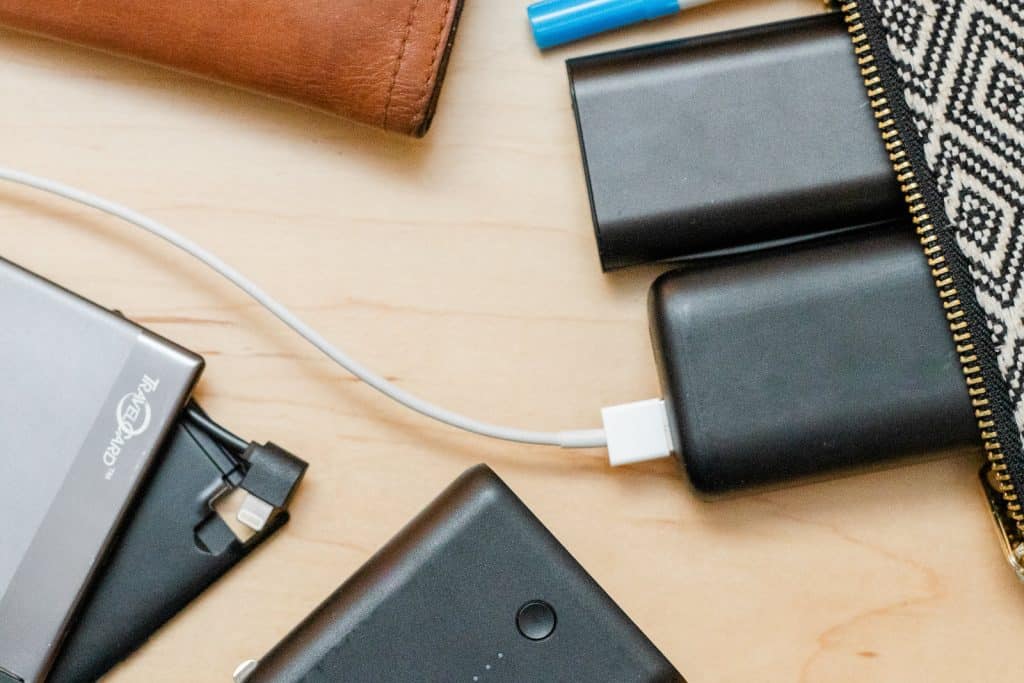
Consider first how much time you’ll be spending away from wall outlets.
USB power banks offer peace of mind when your battery is dead or close to dying but you don’t have access to a wall outlet. After nine hours of research and 30 hours of testing, we’ve found the best USB power banks to meet a wide range of needs—whether you’re looking for a backup boost of power or something that will keep your phone or tablet fully charged for days at a time.
The TravelCard Charger is the best option for someone who wants an emergency boost of power that’s always on hand. It has the lowest capacity of any power bank we tested—it can charge most phones to only around 30 to 50 percent from empty—but it’s unmatched in terms of weight (exactly 2 ounces) and size. It’s bigger and thicker than the average credit card but not by much; it easily fits in a wallet or pocket. It has a built-in USB-A cable to charge it up and a built-in output cable (either Lightning, Micro-USB, or USB-C, depending on which version you need) to top off your phone or another handheld device with a little boost of power.
The Jackery Bolt has been our favorite power bank to carry every day for several years running for a reason. It’s as powerful as it is portable, fitting a high capacity—nearly two full charges for the latest smartphones—into a small package. You can also easily slip it into a small purse or most pants pockets—except maybe your tightest-fitting jeans. The two built-in output cables (Micro-USB and Lightning) mean you don’t need to carry a cable to charge most devices, but it also has a fast-charging USB-A output port if you want to use your own longer cable. It comes with a built-in flashlight, which is a neat bonus.
The Anker PowerCore 10000 PD lacks the built-in cables that set the Jackery and TravelCard models apart, but its capacity (10,000 mAh—enough to fully charge an iPhone XS more than three times) is a lot higher. Plus, in addition to a USB-A output port, it has a USB-C Power Delivery (PD) port that enables charging (both input and output) up to 18 watts—nearly twice as fast as most power banks we’ve found with built-in cables. This means less time waiting around for your phone, tablet, or other device (and the power bank itself) to charge. It’s about the same size and weight (6.9 ounces) as the Jackery, and its rounded edges make it even easier to slide into a pocket or pouch.
The Anker PowerCore Fusion 5000 is handy if you want a single, reliable device that you can plug in the wall to charge your devices overnight and then pack up and carry with you during the day. Its 5,000 mAh capacity is similar to that of the Jackery Bolt, enabling you to fully charge a phone like the iPhone XS more than once, and its two USB-A ports offer fairly fast charging for two devices at a time. We also appreciate that it offers Micro-USB input in addition to a fold-out AC plug—an important feature that other two-in-one models we considered lack. If you want a power bank that doubles as a wall charger, this is the best option we’ve found.
Why you should trust me
As the writer of this guide, I spent nine hours researching and 30 hours testing USB power banks. I’ve been a science writer for more than four years, covering a wide variety of topics from particle physics to satellite remote sensing. Since joining Wirecutter in 2017, I’ve reported on solar battery packs, USB-C cables and adapters, portable laptop chargers, and more.
Who this is for
Most people could use a USB power bank—the question is, which one best fits into your habits? Commuters on public transit may just need a small battery to give their phones a boost at the end of the day, while people who travel a lot may be looking to power multiple devices through long flights and airport layovers. Rather than always having to track down a wall outlet wherever you go, a USB power bank provides a conveniently portable (albeit limited) power supply.
Even if your daily life is blessed with an abundance of charging options—maybe you spend most of your day at home, at the office, or in the car—you could probably still benefit from a power bank. Something wallet-sized is great to always have on hand for those unexpected (yet critical) moments when your phone is dying and no outlets are nearby. But if you want something for weekend trips or a regular commute, slightly larger power banks can easily fit in laptop bags, purses, or large pockets and still offer two or more full charges for most smartphones. These power banks are robust yet portable, allowing you to charge other devices too—wireless headphones, mouse, keyboard, vaporizer, digital camera, and more.
When you’re traveling in an unfamiliar place—relying on your phone to guide you and to potentially call for help—a power bank offers added peace of mind. Having a few of these placed strategically around the house isn’t a bad idea. You can keep one in your foyer to grab as you’re running out the door. Or have a power bank near the couch for when you’re cozily curled up under a blanket and you really, really don’t want to get up to plug in your phone.
If a few phone charges is not enough capacity for you, you might be better off with one of our favorite portable laptop chargers or a USB power bank that’s designed to charge a laptop.
How we picked
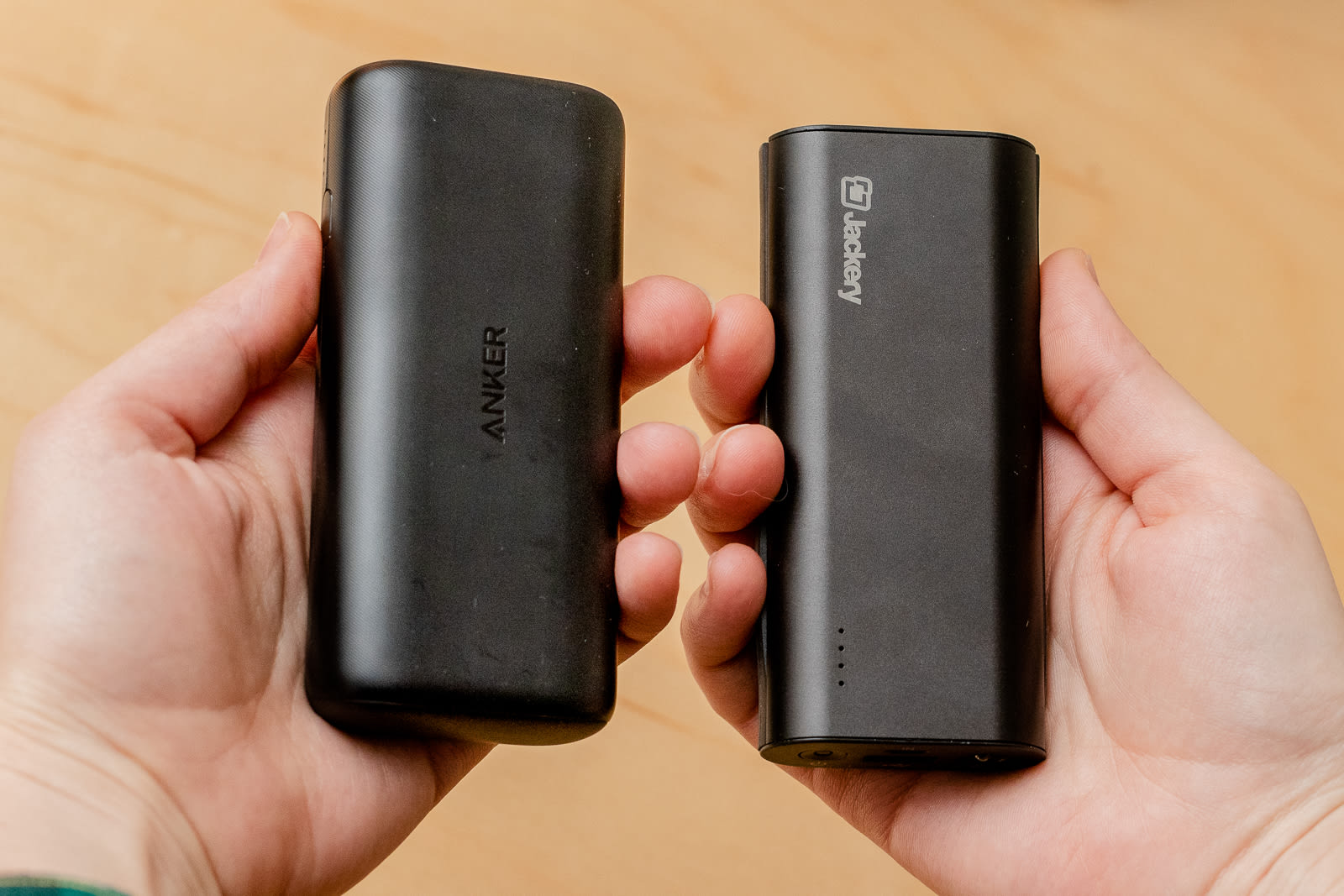
Due to the unfortunate fact that battery technology has failed to keep up with the processing power of our modern devices, USB power banks have become increasingly popular to help our phones and tablets get through the day—and there are tons of brands and models to choose from. We checked out major retailers like Target, Home Depot, and Amazon, as well as trusted editorial sources like Digital Trends, PCMag, PCWorld, and TechRadar, to find the most well-known and widely available makers of USB power banks. From there, we built out a list of contenders based on the following features:
- Powerful input and output: We preferred models with USB-C input or output to be rated for at least 15-watt charging, and models with Micro-USB input or USB-A output to be rated for 8 watts or more. These capabilities ensure top charging (output) and recharging (input) speeds.
- Built-in cables: We preferred that the power banks—especially the smaller, low-capacity models—have some type of built-in cable. This feature is indispensable when done well, because it reduces the number of cables you have to carry around with you and disentangle from the rest of your stuff.
- No heavier than 7 ounces: Power banks should be small and lightweight, making them easy to carry around for an entire day in a wallet, pocket, or bag. We set the weight cutoff at 7 ounces, since an iPhone X weighs about 6.2 ounces, and we don’t think most people want to carry something around in their pocket or purse that weighs much more than a smartphone.
- Capacity rating of 1,000 to 10,000 mAh: The capacity rating listed on the power bank tells you roughly how much power it can hold. For reference, an iPhone X battery has a capacity of 10 Wh (2,700 mAh) and a 15-inch MacBook Pro’s battery has a capacity of about 84 Wh. Power banks with a 10,000+ capacity rating tend to be bigger, heavier, and more expensive, so we focused on lower-capacity power banks for this guide—enough to give your phone a boost of power or fully charge it several times, without weighing you down. Our picks in the best portable laptop chargers offer higher capacities and AC output ports.
- Price: We considered a ratio of capacity (mAh) per dollar to tiebreak between otherwise similar models.
- Brand reputation: We favored brands that we’ve had mostly good experiences with in the past in terms of responsive customer support, widespread availability, and ability to keep products in stock. We discounted crowd-funded or less-established brands, and those lacking a visible Web presence or customer support.
This left us with the following models, which we called in for testing:
- Anker PowerCore 10000 PD
- Anker PowerCore Fusion 5000
- Aukey PB-Y13
- EasyAcc 6000 (Lightning version)
- EasyAcc 6000mAh Ultra-Slim Power Bank
- Jackery 6700mAh Portable Charger with Dual USB Wall Charger
- Jackery Bolt
- Mophie Powerstation Plus Mini (USB-C)
- Mophie Powerstation Plus Mini
- TravelCard Charger
- TravelCard Charger (USB-C)
- Tronsmart Trim 10000mAh USB-C Power Bank
How we tested
We tested the performance of each power bank in a few key areas, including:
- Weight: We used an Escali Primo Digital Scale to confirm the advertised weight of each power bank.
- Size: Rather than measure the length, width, and depth of each power bank—which would have been tedious and not terribly meaningful to most people—we considered size in terms of whether it fit inside a wallet, a pocket (we tried a variety of pants, skirt, and jacket pockets), or an accessory pouch.
- Look and feel: We took note of each power bank’s bulk and exterior texture. We considered how easy and intuitive its features—such as power buttons, charging-status lights, built-in cables, fold-out AC plug, flashlight—were to use.
- Charging output of USB-A ports: We measured USB-A output by connecting a half-charged power bank to a Portapow and a Drok USB Load Tester. We then turned up the amperage of the load tester as far as it could go without overloading the power bank and recorded the volts and amps measured by the Portapow to calculate the maximum output (watts).
- Charging output of USB-C ports: We measured USB-C output by connecting a half-charged power bank to a Total Phase Power Delivery Analyzer, an Apple USB-C cable, and a MacBook Pro. We then used the Total Phase Data Center program, checked over the power profile and any errors, and recorded the volts and amps (to calculate the input in watts).
- USB-C recharging speed: We measured USB-C input by connecting a fully drained power bank to a Total Phase Power Delivery Analyzer, and a 60 W MacBook Pro charger. We then ran the Total Phase Data Center program, checked over the power profile and any errors, and recorded the volts and amps (to calculate the input in watts).
- Micro-USB recharging speed: We measured Micro-USB input by connecting a fully drained power bank to a Portapow USB Power Monitor, an Anker Powerline Micro-USB cable, and an Anker PowerPort 2wall charger plugged into a wall outlet. We then recorded the volts and amps measured by the Portapow to calculate the input (watts).
A little boost of power: TravelCard Charger and TravelCard Charger (USB-C)
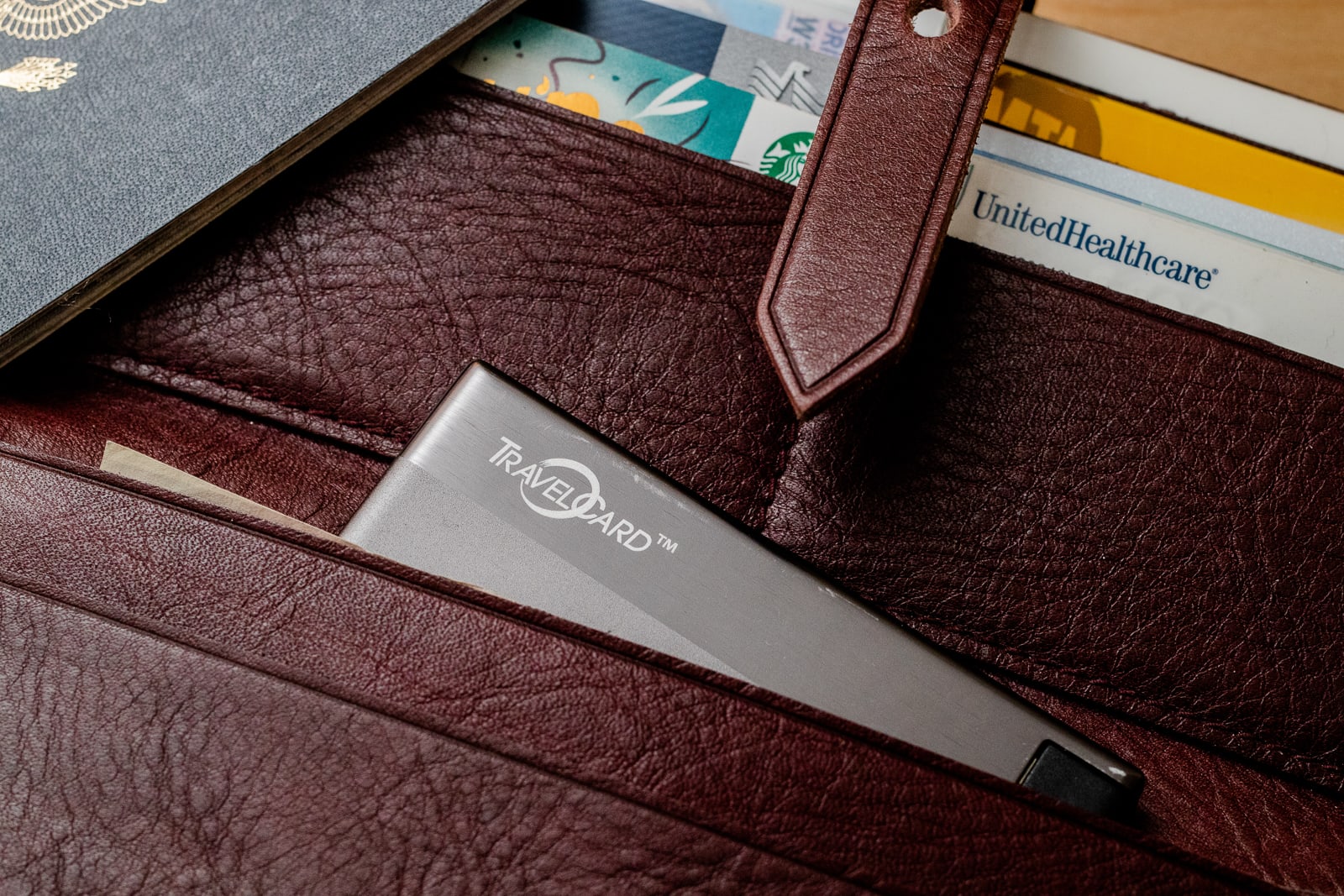
Why we love it: If you want a USB power bank that you can carry around in your wallet or bag for a backup boost of power, you should get the TravelCard Charger (for iPhones) or the TravelCard Charger (USB-C) for devices that charge via USB-C. Neither will fully charge most smartphones but they’re good to have in a pinch. For reference, an iPhone XS requires around 2,700 mAh for a full charge, and these offer only about 1,500 mAh apiece.
They’re impressively powerful for how small (not much bigger or thicker than a credit card) and lightweight (2 ounces) they are. And their built-in cables free up space you’d otherwise have to devote to charging cables. This puts them well ahead of other credit-card-style power banks that lack this feature.
The TravelCard Chargers are totally straightforward to use: You charge them via the built-in USB-A cable, and charge your device using the built-in output cable (either Lightning or USB-C, depending on which one you get). A helpful notification light on the side of the charger next to the power button turns yellow when the battery is low and blue when it’s fully charged. The TravelCards even look like credit cards—with a sleek, metallic exterior—and the built-in cables are easy to pop into and out of their slots.
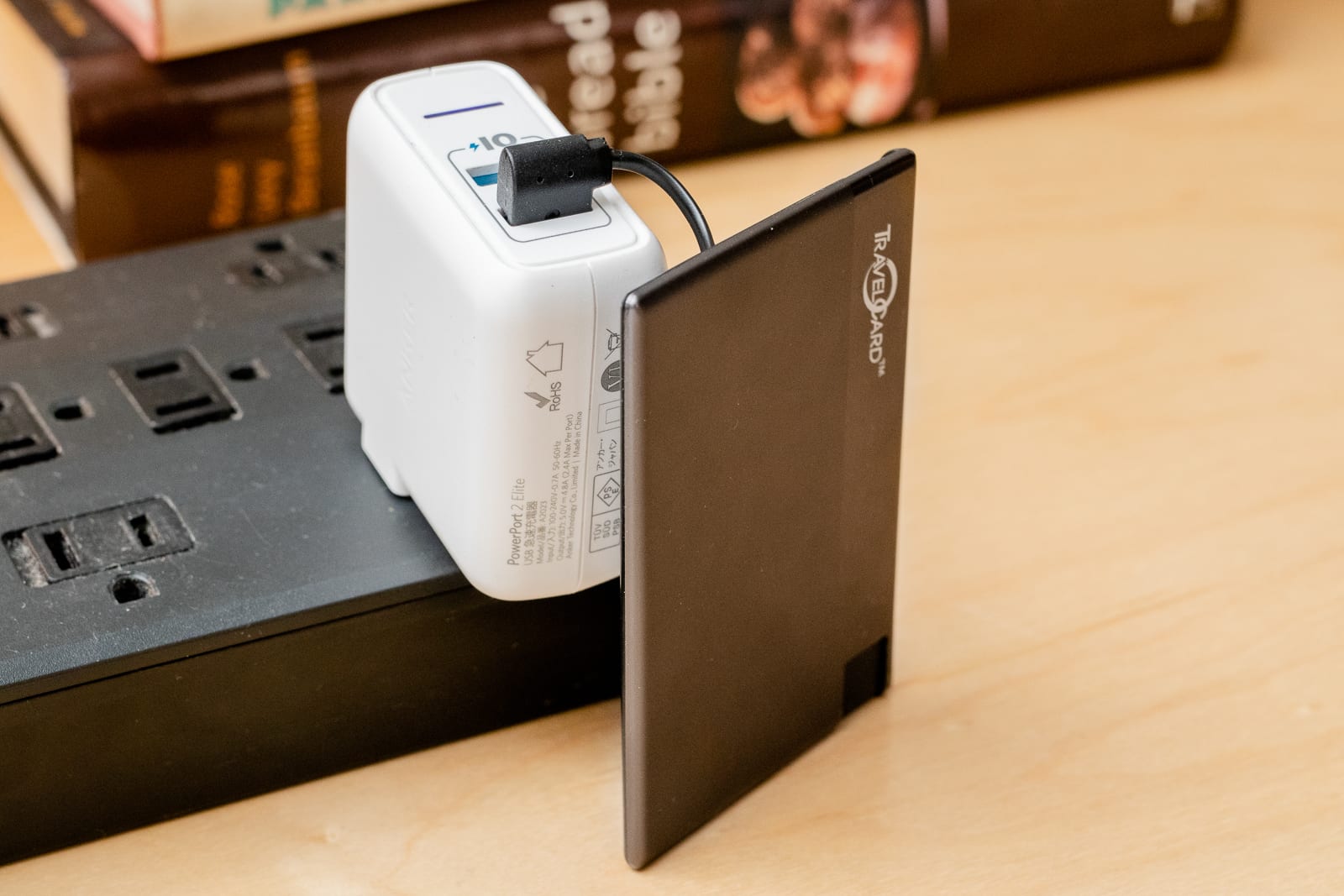
Flaws but not dealbreakers: The TravelCards’ 1,500 mAh capacity rating is the lowest of any model we considered. They have slow charging and recharging rates too—power out and in will go at only about 6 watts. That’s about a third of the charging speed that an iPhone X can handle, so the battery meter will tick up much more slowly. But we think what the TravelCard Chargers lack in power they make up for in portability, and these drawbacks are a small price to pay for the ability to fit a power bank and charging cable in your wallet.
Key specs:
- Capacity rating: 1,500 mAh (5.6 Wh)
- Weight: 2 ounces
- Tested input: 5.8 watts (built-in USB-A cable)
- Tested output: 7.1 watts (built-in Lightning cable) or 5.9 watts (built-in USB-C cable)
Everyday carry: Jackery Bolt
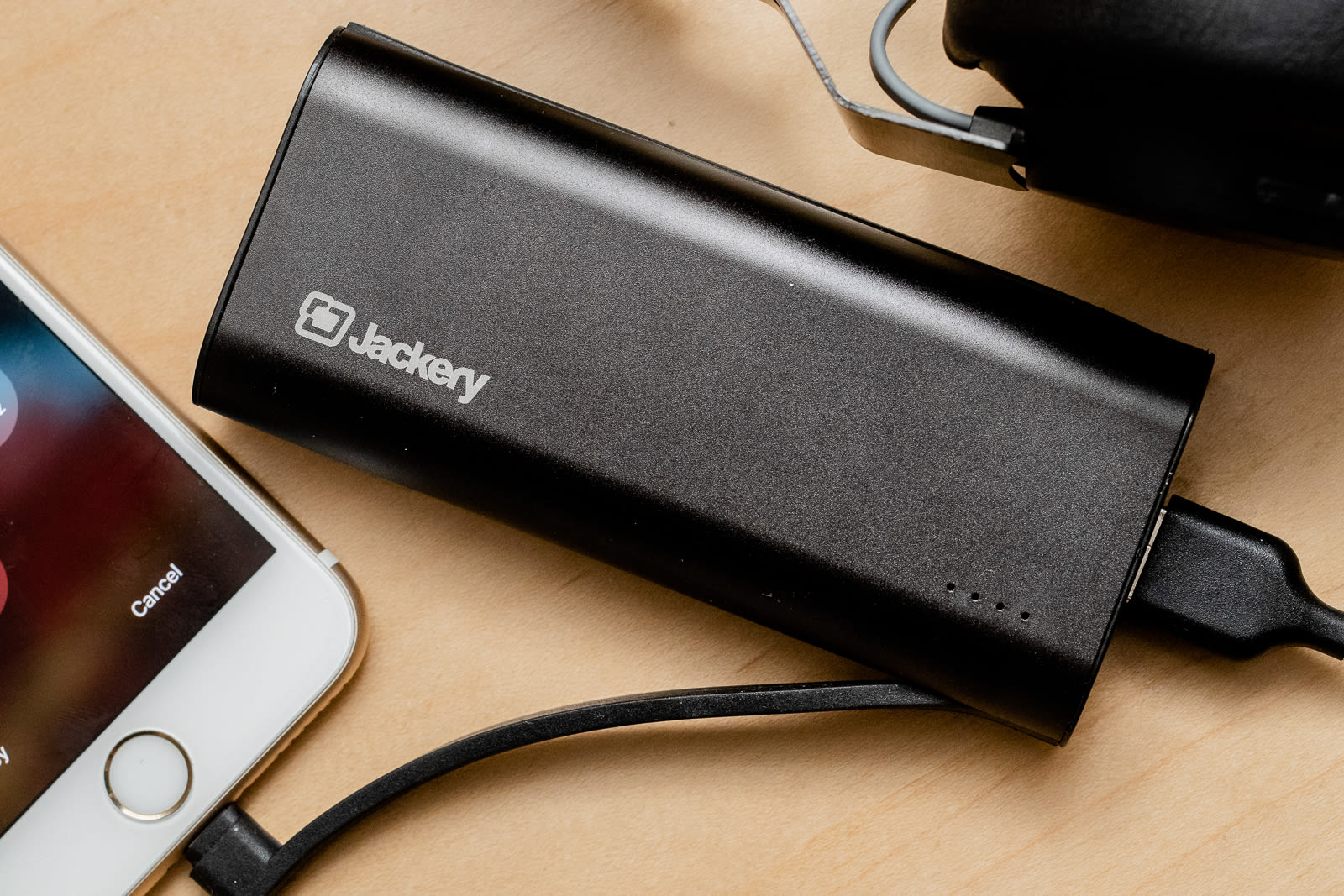
Why we love it: Even if you’ve never owned a USB power bank before, the Jackery Bolt is likely to make you a convert. It’s small and compact—roughly the size of a bar of soap—and weighs only about 5.8 ounces, making it an effortless addition to the existing contents of your purse or backpack. Plus, its built-in Lightning and Micro-USB cables—which smoothly slide into and out of their tiny holsters—negate the need to carry around a tangled mess of various cables. If you want the benefit of a longer cable, though, you can still use one with the Bolt’s USB-A output port.
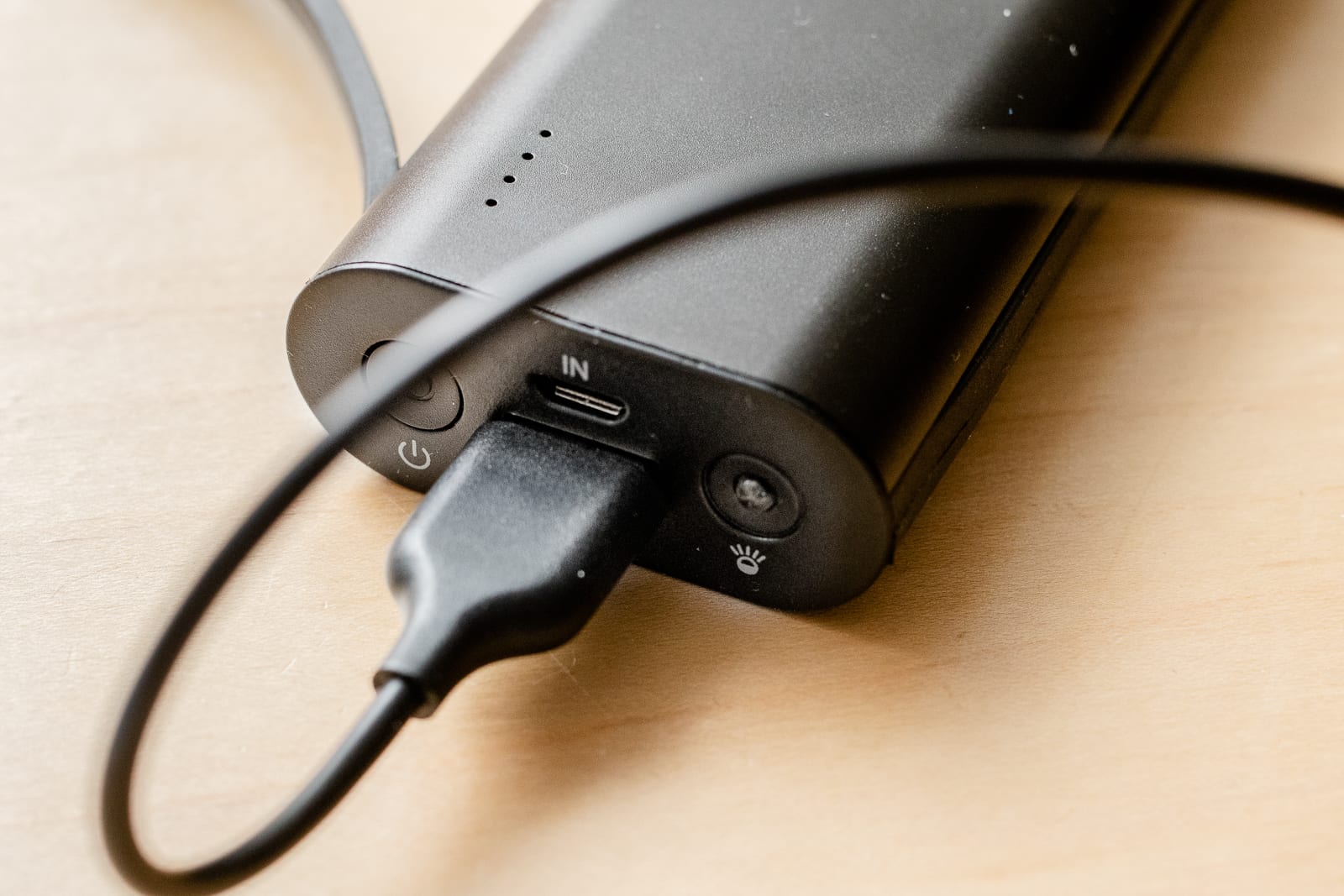
The Jackery Bolt has a capacity rating of 6,000 mAh, which is enough to charge an iPhone X several times over. The Bolt is easy to use and has four pinpricks of blue light along the side that helpfully tell you how much power the bank has left. It also has a little built-in flashlight that doesn’t take up any extra space and can come in handy if you’re digging through your bag to find your keys. This feature, which none of our other picks have, also means that you don’t have to use your phone as a flashlight and further wear down its battery.

Flaws but not dealbreakers: In our testing of the Jackery Bolt’s maximum output, we measured 11.9 watts from the USB-A port, 12.1 watts from the Lightning cable, and 13.8 watts over Micro-USB. That’s about as fast as you can charge most devices from traditional USB, so until Jackery releases a Bolt with USB-C support in this size, we think it’s a fair trade-off. The Bolt’s recharging speed is also fairly slow (we measured up to 8.7 watts), but again it’s a fine trade-off for something that’s highly stowable and portable.
Key specs:
- Capacity rating: 6,000 mAh (22.2 Wh)
- Weight: 5.8 ounces
- Tested input: 8.7 watts (Micro-USB port)
- Tested output: 12.1 watts (built-in Lightning cable) and 13.8 watts (built-in Micro-USB cable); 11.9 watts (USB-A port)
The fastest possible charge: Anker PowerCore 10,000 PD
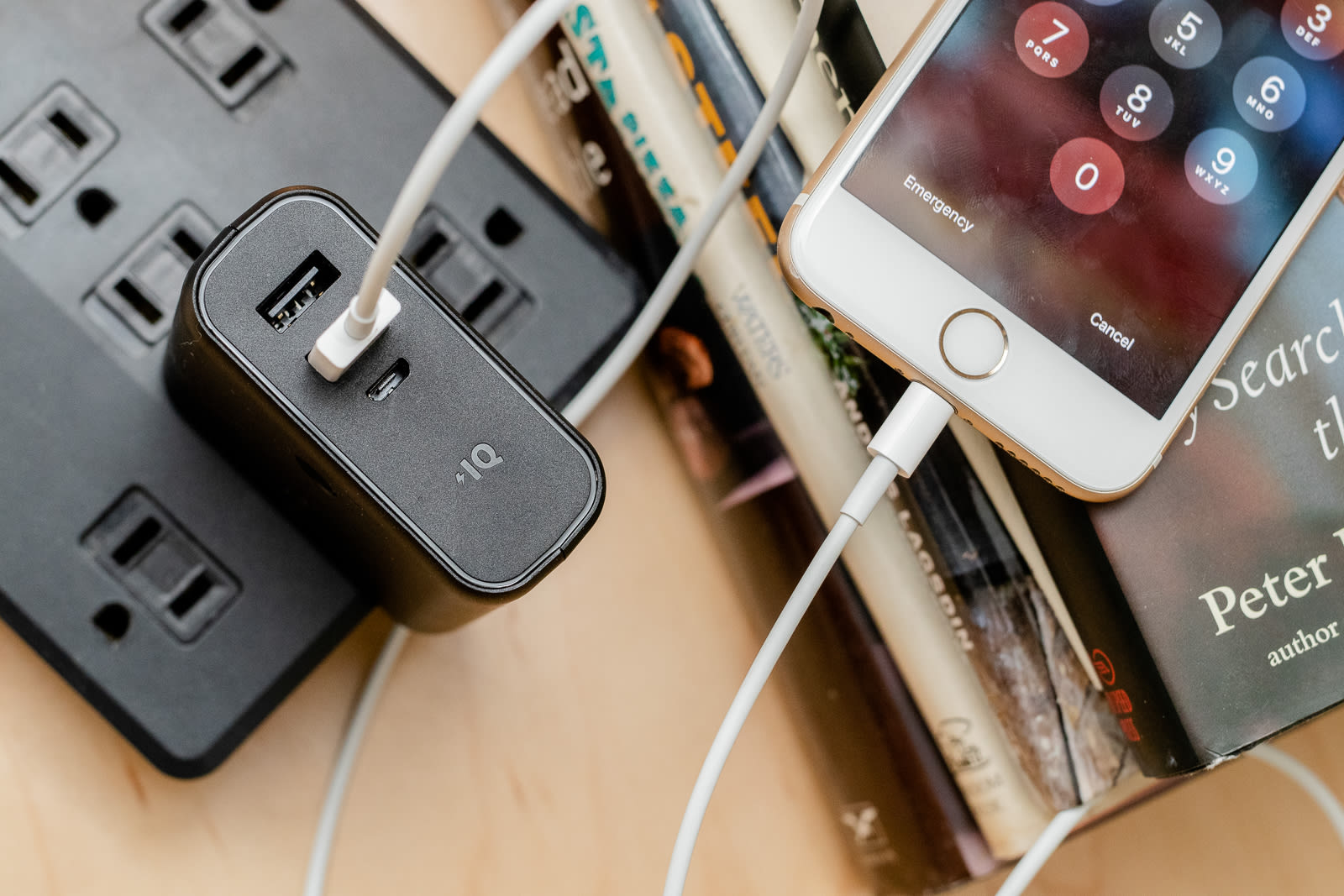
Why we love it: Even without the built-in cables we so prize in our other picks, the Anker PowerCore 10000 PD makes up for it with faster charging and more power. Its rated capacity is 10,000 mAh—more than three full iPhone XS charges, and higher than anything else we tested—and its USB-C Power Delivery (PD) port puts out 18.8 watts of power, which is enough to charge all of the latest phones at top speed.
With a measured input of 15 watts, it can also recharge itself more quickly than any other power bank we tested, so you can get charged up and out the door even faster. Its USB-A port puts out a little less power than our other picks—10.7 watts compared with the Jackery Bolt’s 11.9 watts—but it’s not a noticeable difference in most cases. Like the Jackery Bolt, this Anker is about the same size and shape as a bar of soap. And at 6.9 ounces, it weighs about as much as an iPhone X, not much more than the Jackery Bolt.
Its sleek, jet-black exterior and softly rounded corners make it easy to hold or slide into a pocket. Subtle grooves in the plastic act like the ridges of a fingerprint, giving it an even grippier texture. And four little lights next to the power button tell you how much charge it has left.
Flaws but not dealbreakers: A major drawback with this Anker is its lack of built-in cables. We’d always prefer built-in cables over having to supply and transport our own cables, because they take up space, get tangled, and are easily misplaced. But we’ve yet to find a power bank with built-in cables that’s as small as this one and that also offers the faster charging of USB-C PD input and output. If you want the fastest possible charge and the highest capacity of any power bank we tested—and can bear to carry around a separate charging cable or two—this is a great option.
Key specs:
- Capacity rating: 10,000 mAh (37 Wh)
- Weight: 6.9 ounces
- Tested input: 15 watts (USB PD port)
- Tested output: 18.8 watts (USB PD port) and 10.7 watts (USB-A port)
Doubles as a wall charger: Anker PowerCore Fusion 5000

Why we love it: The Anker PowerCore Fusion 5000 is the best power bank we’ve found that’s also a good wall charger. Rather than having a wall charger that you leave at home and a separate power bank that you carry with you, this is a single gadget that does double duty. It’s easy to use: Flip open the AC plug and stick it in a wall outlet to charge it, wait for the three little battery-status lights on the side to light up, then take it with you for hours of portable power. And you don’t have to worry about your power bank dying while you’re out and about, because you can charge it from any wall outlet.
The Fusion 5000 is relatively small—about the size of a standard tape measure—and you can easily stow it in an accessories pouch or a large pocket. Its rated capacity (5,000 mAh—a bit less than two full iPhone XS charges) is similar to that of the Jackery Bolt. Each of its two USB-A output ports can send plenty of power to your devices, charging them faster than any other USB-A ports we tested. We measured 12.5 watts when it was plugged into a wall outlet and 15.5 watts when unplugged, which will charge your phone a lot faster than the 5-watt charging brick that comes with an iPhone. You can recharge it via the AC input plug (which sends 11.4 watts of power to the Fusion from a wall outlet, according to the test we ran with a Kill A Watt Electricity Usage Monitor) or the 9.9-watt Micro-USB input port, which is convenient if you want to recharge the Fusion from a laptop or some other USB power source. Given its capacity, that means it should take 1.6 hours to charge itself over AC or almost 2 hours over Micro-USB, according to our tests.
The Anker PowerCore Fusion 5000 excels as both a wall charger and a power bank.
Flaws but not dealbreakers: We would have liked to see a USB-C output port incorporated into this model, since USB-C is faster and increasingly common. We know the technology exists, because the Jackery 6700mAh Portable Charger with Dual USB Wall Charger we tested has this capability. Another big drawback with the Fusion is that it’s less portable than something like the Jackery Bolt: It has a chunkier shape that’s not as easy to slip into a pocket, and its lack of built-in cables requires you to pack an extra cable or two to charge your devices. As far as two-in-one power banks go, though, it’s still fairly compact.
Key specs:
- Capacity rating: 5,000 mAh (18.5 Wh)
- Weight: 6.6 ounces
- Tested input: 11.4 watts (built-in AC plug) and 9.9 watts (Micro-USB port)
- Tested output: 12.5 watts (USB-A port when plugged in) and 15.5 watts (USB-A port when unplugged)
What to look forward to
We’re working on a guide to USB power banks for laptops, which will complement this guide and our guide to the best portable laptop chargers.
Anker sells a two-in-one power bank at the Apple Store called the Anker PowerCore Fusion Power Delivery Battery and Charger, which is sort of a mashup of our favorite PD wall charger and the PowerCore Fusion 5000. In addition to a USB-A output port, it has a PD output port rated for 30 watts that should allow it to charge a MacBook Pro—something that neither of the two-in-ones we tested (the Jackery and Anker) can do. But, even so, we think its $100 price (at the time of this writing) is too steep for a 5,000 mAh power bank.
Anker briefly released a 10,000 mAh version of the Fusion with a USB-A port and 15-watt USB-C port in January 2019, but it’s currently unavailable. We’ll test it as soon as we can and update this guide with our thoughts.
The competition
Mophie Powerstation Plus Mini (USB-C): The built-in USB-C cable on this power bank is very tricky to get back into the slot, which we think would drive most people up the wall. It’s also much bigger and heavier than the TravelCard Charger (USB-C), which is the only other model we considered that solely offers USB-C output.
Mophie Powerstation Plus Mini: The adapter that lets you turn the built-in Micro-USB cable into a built-in Lightning cable is a nice idea but it’s not super smooth to slide on and off. It also seems like it would get lost easily since it’s not tethered to anything, and without it the power bank is nearly worthless: you lose the Lightning output function altogether, and the Micro-USB cable still works but doesn’t stay firmly in its slot.
EasyAcc 6000 (Lightning version) and EasyAcc 6000mAh Ultra-Slim Power Bank: These power banks are lightweight (4 ounces) and as high-capacity (6,000 mAh) as the Jackery Bolt. But we think the Bolt’s smaller size (in terms of height and width) make it easier to hold in your hand and fit into a pocket. Plus, the Bolt has two built-in cables (Micro-USB and Lightning) while each of these models only offer one or the other.
Tronsmart Trim 10000mAh USB-C Power Bank and Aukey PB-Y13: These power banks have the same capacity (10,000 mAh) as the Anker PowerCore 10000 PD, plus (unlike the Anker) they offer Micro-USB input and Quick Charge 3.0 output. But we don’t think either feature is a huge benefit to most people. Also, based on our past experience with all three brands, we think the C-to-C cable that comes with the Anker model is a better value than the Aukey A-to-C cable or the Tronsmart Micro-USB cable.
Jackery 6700mAh Portable Charger with Dual USB Wall Charger: This two-in-one power bank has USB-C and USB-A output but it’s about a half inch wider than the Fusion and has only AC input—whereas the Fusion has a Micro-USB input port in addition to AC input.


